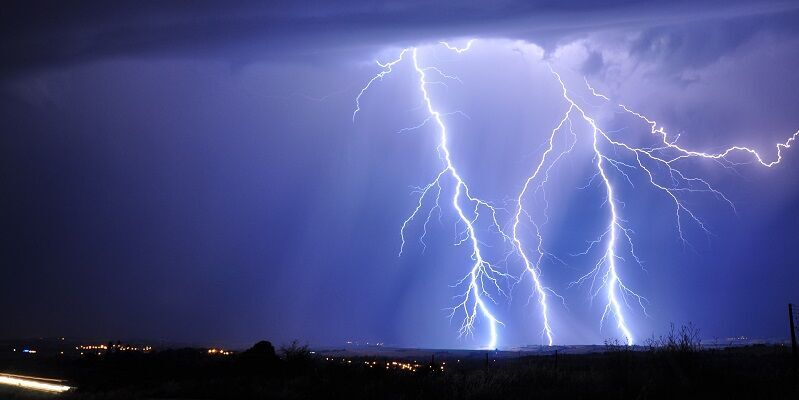日期 一項新的研究表明,全球變暖可能導致雷擊減少,影響熱帶地區的大氣成分和天然森林火災的頻率。 包括利茲大學的Declan Finney博士和Alan Blyth教授在內的科學家使用一種新設計的方法預測,如果全球氣溫繼續保持其預測的上升趨勢,到2100年,全球平均閃電數量將下降15%。 該研究的主要作者,來自利茲氣候與大氣科學研究所的Finney博士在愛丁堡大學進行了這項研究。他說:“我們的方法仔細研究了氣候變化對導致閃電的基本組成部分的影響。 “預計下個世紀的全球變暖將改變大氣溫度、濕度和穩定性。這將對冰粒和軟冰雹產生重大影響,當它們在雷暴中碰撞時會積聚電荷。正是云層中的這種電荷在暴風雨期間產生了閃電和雷聲。 “云冰量的增加或云中上升氣流強度的增加導致產生的電荷增加,從而增加閃電的數量。 “該研究中使用的氣候變化情景是,到2100年,全球氣溫將上升約5攝氏度。在這種情況下,云冰顆粒的形成和運動會產生很大影響,導致閃電發生率顯著下降。 閃電是一氧化氮的重要來源,一氧化氮是臭氧的前體,會影響甲烷的壽命。低層大氣中的臭氧和甲烷都是重要的溫室氣體,其濃度的變化會導致大氣變暖或變冷。 這項研究今天發表在《自然氣候變化》雜志上,呼吁在化學氣候模型中模擬閃電,以納入更多閃電產生的基本物理學。從而更好地模擬大氣成分與氣候變化之間的相互作用和反饋。 芬尼博士說:“了解閃電的未來變化對于預測氣溶膠化學的后續變化、雷擊引發的自然野火以及閃電對基礎設施的破壞非常重要。我們觀察到的最大差異是在熱帶地區,那里發生的閃電最多,是自然野火的主要點火源。 該研究的共同作者、美國國家大氣科學中心大氣物理學主任艾倫·布萊斯教授說:“顯示未來氣候中閃電減少的新結果很有趣,不僅挑戰了以更基于物理的方式在化學氣候模型中表示閃電的方式,而且還挑戰了混合相云 - 由過冷云滴和冰晶組成的云。 以前的研究使用云頂高度來預測閃電頻率和氣候變化的潛在影響。雖然這些方法表明全球變暖可能導致閃電發生率增加,但該研究強調了這種方法的弱點,包括閃電不是由云的高度引起的,而是由冰粒碰撞產生的電荷引起的。 芬尼博士說:“這里的方法將云冰的運動與閃電活動聯系起來,與以前用于模擬氣候變化的方法相比,它包含了更多控制閃電形成的基本物理學。我們的研究質疑先前閃電預測的可靠性,并鼓勵進一步研究氣候變化對云冰和閃電的影響。在變暖的星球上不太可能發生閃電風暴

對大氣的影響
當前方法的弱點
Lightning storms less likely in a warming planet
Date

Global warming may lead to a drop in lightning strikes, affecting atmospheric composition and the frequency of natural forest fires in the tropics, a new study suggests.
Using a newly-devised method, scientists including Dr Declan Finney and Professor Alan Blyth from the University of Leeds, have forecast a 15 per cent drop in the average number of lightning flashes worldwide by the year 2100, if global temperatures continue on their predicted upward trend.
Study lead author Dr Finney, from the Institute for Climate and Atmospheric Science at Leeds, carried out this research while based at the University of Edinburgh. He said: “Our method looked closely at the impact of climate change on the fundamental components that lead to lightning.
“Global warming over the next century is expected to alter atmospheric temperature, humidity and stability. This would have a significant effect on the ice particles and soft hail which build up electrical charge when they collide in thunderstorms. It’s this charge in clouds that generates the lightning flashes and thunder during storms.
“Increases in the amount of cloud ice or the strength of the updraughts in the clouds leads to an increase in the charge generated and therefore the number of lightning flashes.
“The climate change scenario used in the study was an approximate five degree Celsius rise in global temperatures by 2100. Under this scenario there are large impacts on the formation and movement cloud ice particles, leading to a significant drop in lightning occurrence.”
Lightning is an important source of nitric oxide – which is a precursor of ozone, and which influences the lifetime methane. Both ozone in the lower atmosphere and methane are important greenhouse gases, and changes in their concentrations can lead to warming or cooling effects on the atmosphere.
The study, published today in Nature Climate Change, calls for lightning simulated in chemistry-climate models to incorporate more of the underlying physics of lightning generation. And thereby better simulate the interactions and feedbacks between atmospheric composition and climate change.
Dr Finney said: “Understanding the future changes in lightning is of importance to predicting subsequent changes in aerosol chemistry, natural wild-fires ignited by lightning strikes, and lightning damage to infrastructure. The largest difference we observed was in the tropics, where the most lightning occurs and are the main source of ignition for natural wild-fires.”
Study co-author Professor Alan Blyth, Director of Atmospheric Physics at the National Centre for Atmospheric Science, said: “The new results showing a decrease of lightning in a future climate are interesting and challenge not only the way of representing lightning in chemistry-climate models in a more physically-based way, but also mixed-phase clouds – clouds that are made up of supercooled cloud droplets and ice crystals.”
Previous studies have used cloud-top height to predict lightning frequency and the potential impact of climate change. While these methods have indicated global warming could lead to an increase in lightning occurrences, the study highlights the weaknesses in this approach, including the fact that lightning is not caused by the height of the cloud but by the electrical charge built up through collisions of ice particles.
Dr Finney said: “The method here, which relates the motions of cloud ice to lightning activity, incorporates much more of the fundamental physics governing lightning formation than previous methods applied to simulations of climate change. Our research questions the reliability of previous projections of lightning, and encourages further study into the effects of climate change on cloud ice and lightning.”
上一篇:委內瑞拉的馬拉開波湖因閃電濃度最高而被列入吉尼斯世界紀錄。
下一篇:氣象學家杰夫·哈比(JEFF HABY) 暴風雨在 0.8 平方英里的區域內平均降雨量為 135 英寸